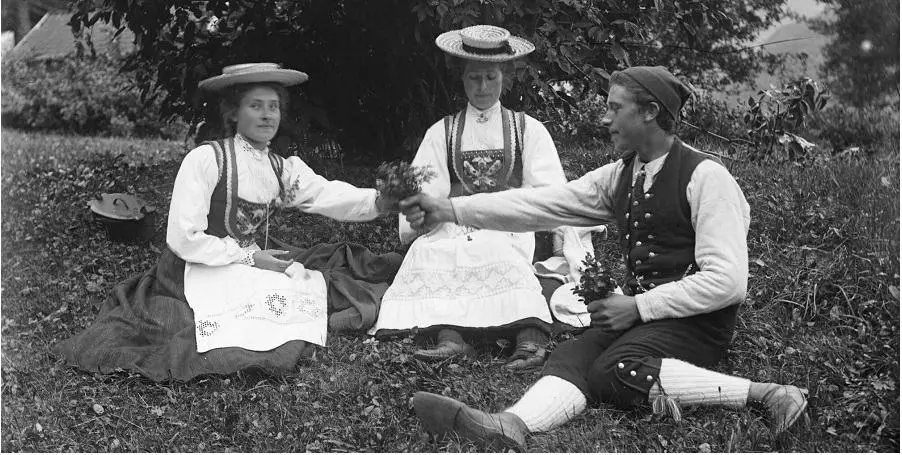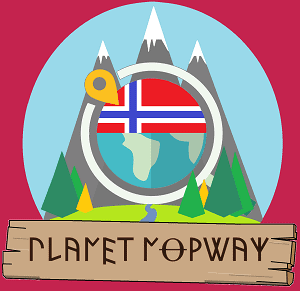In addition to their stunning nature, fresh air, blonde hair, and blue eyes, Norway and Norwegians have become known for their traditional folk costumes.
There are numerous variations across different regions, most of which can be seen during celebrations such as the 17th of May, Norway’s constitution day. Contrary to popular belief, the bunad is not as traditional as people and Norwegians like to think. The modern bunad tradition began at the end of the 19th century. With some exceptions, most were designed in the early to the mid-20th century.
Today, there are around 450 different bunads in Norway. Continue reading to learn more about the beautiful Norwegian bunads, and where you can get one for yourself.

History of the bunad
While Norway has long clothing traditions, the bunad, as a folk dress used on celebrations and on special occasions is a relatively modern concept.
Certain bunads are the latest version of traditional folk dresses whose tradition goes a long way back. This includes both the Hardangerbunad and the Hallingstakk, which have gone from being typical, everyday clothing, to Sunday clothing to being bunads.
Most bunads are rather modern, being designed between the late 1800s and the early- to mid-1900s. They are typically made for a certain region of Norway and are loosely based on and inspired by individual garments, local rose paint, or other decorative elements from that specific region.
The mother of the Bunad
The work of making the bunad an alternative to contemporary fashion began at the end of the 19th century. The movement gained huge momentum in the years around the dissolution of the union with Sweden in 1905.
One of the central figures in the bunad movement was Hulda Garborg. She was a writer, poet, playwright, and an active public debater and idealist fronting cause such as theatrical work, women’s issues, folk dance, and the use of the bunad.
In 1903 she published the book Norsk Klædebunad (Norwegian bunad). Here, she presented some of the folk costumes that were still in use and spoke warmly about the importance of using Norwegian materials rather than imported silk and velvet.
This spurred enthusiasts all over the country to form handicraft clubs that prepared their own local bunads based on established local customs, older garments, and local folk art.
The modern tradition
Ever since the pioneering work and effort of Garborg, local handicraft clubs (husflidslag) have kept the tradition alive and growing. In 1947, the Norwegian Institute for bunad and folk costumes was formed. This organization assists with reconstructions, documents costume finds and safeguards the Norwegian costume tradition to this day.
Today, there are around 450 different bunads in Norway. Around 80 percent of Norwegian women own a bunad. Among men, there is just over 20 percent, but the number is increasing.
The costume is used by all age groups, regardless of education, social status, and where in the country you live. Traditionally, you would wear a bunad from the area you live or where your family comes from. This is still the case today, however, more and more Norwegians choose according to what they think is nice.
The bunad is typically used for celebrations such as baptisms, confirmations, weddings, and diploma ceremonies. However, the day most Norwegians put on their bunad is the 17. May, Norway’s constitution day.
How bunads are made
While you can buy mass-produced bunads, proper bunads are hand-sewn by certified Bunad tailors. This is time-consuming work that requires a lot of knowledge. It includes working with various types of textiles which a huge variety of patterns and embroidery. It also requires making accessories such as knitted socks, trousers, woven belts, and beadwork.
Most bunads have traditionally been sewn locally by village tailors and seamstresses, at Husflidutslag and other dealers. For many years, the knowledge was passed down from one generation to the next.
Over time, most local handicraft clubs (husflidslag) have documented and formalized much of this knowledge in order to preserve it for future generations. Today, many hudflidslag regularly hold courses where individuals can learn how to make their own bunad.
Most popular/beautiful bunads
As mentioned, there are some 450 different bunads across Norway. Because most people traditionally get a bunad from an area they belong to, the most popular ones are going to be the ones where most people live. This also makes most Norwegians biased as to which is the most beautiful.
That being said, there is an increasing trend of choosing the bunad you like the most or one from an area where one’s family has roots. This is especially true in Oslo. Somehow there is a surprising amount of people from Telemark who choose to celebrate the 17th of May in Oslo.
However, there are a few bunads that stand out as the most popular/beautiful. These are the woman and men bunads from Hardanger (Greater Bergen region), Eastern Telemark (Øst-Telemark), and Northern Norway (Nordland)
Hardangerbunad
The hardangerbunad comes from the district of Hardanger in western Norway (greater bergen area). It is one of the few bunads whose that is considered to be the latest version of a traditional national costume. From its use as everyday attire, its use has been continuous throughout the years until it became Norway’s first bunad.
The woman’s bunad has a red waist with a slant and a white apron. It is common to get a woven belt and hanging bands when you are confirmed. Later, a special headdress and decorative belt separate the unmarried girl from the married ones.
The male bunad was out of use for a longer period and almost lost, but was revived in the 1920-1930s. With the help of plenty of source material the bunad came back to life and is one of the most popular and beautiful male bunads.
Øst-Telemark
East Telemark has strong costume traditions and the region is home to some of Norway’s most beautiful bunads.
For women, the east telemark bunad comes in different varieties, but all are based on source material from the 1820-the 1850s around Heddal in central Telemark. A central feature of the bunad is the execution of the traditional rose stitch in embroidery.
Another bunad from eastern telemark is the beltestakk. It is characterized by a thick, woven waist belt. While similar, many features separate it from the east telemark bunad.
The men’s bunad from eastern telemark is one of the most distinguishable in Norway. Based on traditional garments from the 1800s, the jacket has a distinguishable collar and comes with different decorations. The jacket is typically white or gray, but there are also green variants. Furthermore, it comes with wool knickers and hand-knitted wool stockings.
Nordlandsbunad
The Nordlandsbunad is the most popular bunad from northern Norway. Its use is widespread from the Nordland region just north of Trøndelag and Trondheim, to Tromsø in the far north. It was first presented at a convention in Leirfjord in 1928 and has since become one of the most popular and beautiful bunads for both men and women.
For women, There are 2 colors to choose from, Blue and Green, with blue being the most popular. It comes with a white stitch embroidered linen shirt and an apron and shawl woven in mercerized cotton.
The first nordlandsbunad for men was sewn in Harstad in 1924. It was made for a groom by the name of Johannes Eidnes who had actively collected source material for his costume throughout northern Norway. The costume gained popularity, and today, it is one of Norway’s most popular male bunad with its decorative vest and black jacket, and knickers.
How much does a bunad cost?
The price of a bunad varies a lot. A tailor-made bunad from a trained bunad tailor will cost north of 2300 USD/2000 EUR. Depending on the type of bunad and the number of silver accessories they might cost up to 5800 USD/4900 EUR.
Norske bunader offers a variety of bunads that are sewn by tailors in china. These are not official bunads and are cheaper. Still, they typically cost around 2300 USD/2000 EUR without silver accessories.
Finally, there is also the possibility to buy generic, bunad-like attires known as festdrakter. These resemble bunads and are mass-produced, making them a lot cheaper. They are a great option for growing kids.
Closing remarks
The Norwegian bunad is a special outfit rooted in traditional Norwegian clothing and culture. Every year, more and more Norwegians decide to get a bunad to celebrate their culture and heritage.
There is a vast number to choose from, with each one being special to a certain region. Even though they can be very expensive, there are ways to get one at an affordable price.
